

Dipsticks: Efficient Ways to Check for Understanding. What strategy can double student learning gains?

According to 250 empirical studies, the answer is formative assessment, defined by Bill Younglove as “the frequent, interactive checking of student progress and understanding in order to identify learning needs and adjust teaching appropriately.” Unlike summative assessment, which evaluates student learning according to a benchmark, formative assessment monitors student understanding so that kids are always aware of their academic strengths and learning gaps. It also helps teachers improve the effectiveness of their instruction. “When the cook tastes the soup,” writes Robert E. Stake, “that's formative; when the guests taste the soup, that’s summative.” Alternative formative assessment (AFA) strategies can be as simple (and important) as checking the oil in your car—hence the name “dipsticks.” You can find another 53 ways to check for understanding toward the end of this post and as a downloadable document.
Other Assessment Resources. What is teaching? A definition and discussion. Contents: introduction • what is teaching?

• a definition of teaching • teaching, pedagogy and didactics • approaching teaching as a process • structuring interventions and making use of different methods • what does good teaching look like? • conclusion • further reading and references • acknowledgements • how to cite this piece Linked piece: the key activities of teaching A definition for starters: Teaching is the process of attending to people’s needs, experiences and feelings, and making specific interventions to help them learn particular things. In teacher education programmes – and in continuing professional development – a lot of time is devoted to the ‘what’ of teaching – what areas we should we cover, what resources do we need and so on. . … do we ask the “who” question – who is the self that teaches? The thing about this is that the who, what, why and how of teaching cannot be answered seriously without exploring the nature of teaching itself.
How to Make Sure That Project-based Learning is Applied Well in Schools. By Thom Markham Now that project-based learning (PBL) is becoming more popular, the doubters and haters also have surfaced.
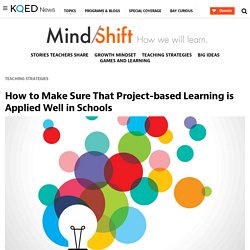
The recent anti-PBL message by David Brooks in the New York Times, which was fortunately well rebutted, exemplifies the resistance. Citing High Tech High in San Diego, Brooks’ core message is that PBL is a kind of mindless education dressed up by technology and devoid of the ‘wisdom’ taught in traditional schools. Given that there are probably another thousand-plus schools across the country embracing PBL, this is a serious charge. Glogin?mobile=1&URI=http%3A%2F%2Fmobile.nytimes.com%2F2015%2F03%2F01%2Fopinion%2Fsunday%2Fmake-school-a-democracy. Photo.
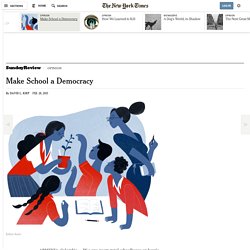
Unexpected Tools That are Influencing the Future of Education. Mia Christopher Some big education issues have been making headlines, including how many and what kind of standardized tests should be used in education, implementation of Common Core State Standards and the Vergara ruling in California challenging teacher tenure.

But many educators continue to focus on the more personal issues behind these headlines: how to improve their craft, serve students better, nurture well-rounded, emotionally intelligent students and make educational change in more fundamental ways. Teachers have long known that struggles in the classroom are often a reflection of society as much as of academic ability. And beyond the many challenges related to rising poverty rates, there is the uniquely confusing moment in which society finds itself. Around the globe, economies are shifting away from machine-focused industries and toward human-powered creative industries. Saying students should drive their own learning is much easier than helping them do it.
Is Lecturing Culturally Biased? For years, politicians and policy makers have cried out for more students to complete STEM degrees to improve the nation's workforce.
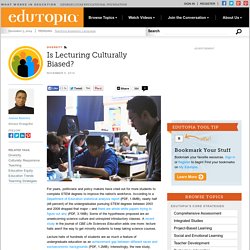
According to a Department of Education statistical analysis report (PDF, 1.6MB), nearly half (48 percent) of the undergraduates pursuing STEM degrees between 2003 and 2009 dropped that major -- and there are whole white papers trying to figure out why (PDF, 3.1MB). Some of the hypotheses proposed are an unwelcoming science culture and uninspired introductory classes. A recent study in the journal of CBE Life Sciences Education adds one more: lecture halls aren't the way to get minority students to keep taking science courses. Experiential Learning & Experiential Education: Philosophy, theory, practice & resources. Several authors (e.g., Kraft, 1991; Richards, 1977) have pointed out that experiential learning dates back beyond recorded history and remains pervasive in current society, whether formalized by educational institutions or occurring informally in day-to-day life.
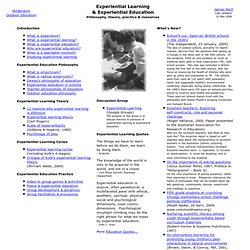
In this sense, experiential learning is not an alternative approach, but the most traditional and fundamental method of human learning. Ironically, the current perception of experiential education as different is probably less due to new developments in experiential learning than it is to the normalization of didactic teaching as the mainstream educational methodology. Since the 1950's there has been a growing focus in writings and research specifically on experiential learning. PowerPoint in higher education is ruining teaching. Www.ius.edu/ilte/pdf/BarrTagg.pdf. Www.wcer.wisc.edu/archive/cl1/cl/resource/scismet.pdf. Www.edutopia.org/pdfs/edutopia-teaching-for-meaningful-learning.pdf. Piaget's theory of cognitive development. Piaget's theory of cognitive development is a comprehensive theory about the nature and development of human intelligence, first developed by Swiss developmental psychologist Jean Piaget (1896–1980).

It is primarily known as a developmental stage theory but, in fact, it deals with the nature of knowledge itself and how humans come gradually to acquire, construct, and use it. To Piaget, cognitive development was a progressive reorganization of mental processes as a result of biological maturation and environmental experience. Accordingly, children construct an understanding of the world around them, then experience discrepancies between what they already know and what they discover in their environment.[1] Moreover, Piaget claimed the idea that cognitive development is at the center of human organism, and language is contingent on cognitive development. Learner-Centered Teaching. Learner-Centered Teaching Phyllis Blumberg, Ph.D.

Director of the Teaching and Learning Center University of the Sciences in Philadelphia 1. Most of this material comes from Blumberg, P. (2008) Developing Learner-Centered Teachers: A Practical Guide for Faculty. San Francisco: Jossey-Bass. This site contains links to presentation or workshops I have done at various places over the past few years. Versions of most of these workshops have been offered repeatedly to new faculty at the University of the Sciences, at the Lilly Conference, The Teaching Professor Conference, the POD Network conference and to faculty at various colleges and universities in the USA and around the world and trainers for the United States Army.
Biography of Maria Montessori. Maria Montessori was an Italian physician, educator, and innovator, acclaimed for her educational method that builds on the way children naturally learn.
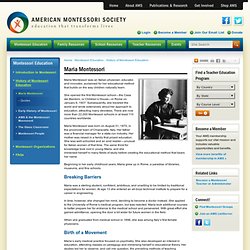
She opened the first Montessori school—the Casa dei Bambini, or Children’s House—in Rome on January 6, 1907. Subsequently, she traveled the world and wrote extensively about her approach to education, attracting many devotees. There are now more than 22,000 Montessori schools in at least 110 countries worldwide. Maria Montessori was born on August 31, 1870, in the provincial town of Chiaravalle, Italy. Her father was a financial manager for a state-run industry. Www.ydae.purdue.edu/lct/hbcu/documents/Active_Learning_Creating_Excitement_in_the_Classroom.pdf.
Student-Centered Teaching. In the traditional approach to college teaching, most class time is spent with the professor lecturing and the students watching and listening. The students work individually on assignments, and cooperation is discouraged. Learner-centered teaching methods shift the focus of activity from the teacher to the learners. These methods include active learning, in which students solve problems, answer questions, formulate questions of their own, discuss, explain, debate, or brainstorm during class; cooperative learning, in which students work in teams on problems and projects under conditions that assure both positive interdependence and individual accountability; and inductive teaching and learning, in which students are first presented with challenges (questions or problems) and learn the course material in the context of addressing the challenges. Videos and Publications on Active Learning Publications on Cooperative Learning General principles and strategies.
The National Academies Press Discovery Engine. Theories of Cognitive Development: Lev Vygotsky. Learner Autonomy: A Guide to Developing Learner Responsibility - Agota Scharle, Anita Szabo. Files/2010/03/Froyd_Stu-CenteredLearning.pdf. Student-centred learning. Reference.sit.edu:2048/login?url= Reference.sit.edu:2048/login?url= Reference.sit.edu:2048/login?url=
Academic.regis.edu/ed205/Kolb.pdf. Www.d.umn.edu/~kgilbert/educ5165-731/Readings/experiential-learning-theory.pdf. Learner-based Teaching.